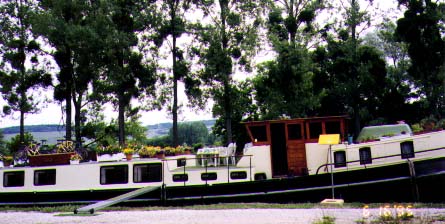
The Lanikai, moored for the evening

The Lanikai, moored for the evening
The Lanikai was moored in a wide spot in the Burgundy canal, near a small village. We met the other guests for the week, Kaje and Gina, and the deckhand, Ryan. The Lanikai is a 95-foot former working barge that has been converted into a floating hotel; its three cabins can accommodate six guests. Each cabin has its own private toilet and shower. Amidships is the salon, a comfortable well-lit area with a sofa, chairs, stereo system and a wood-burning stove. This area is also the dining area, although meals are usually eaten on deck, weather permitting.
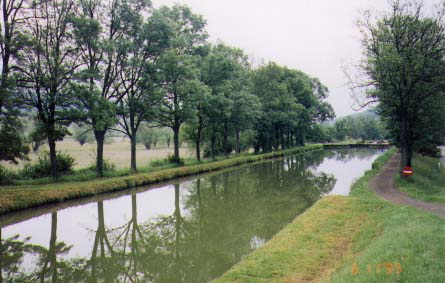
The Burgundy canal
We had a delicious 'welcome aboard' dinner (a taste of things to come), and spent the evening wandering along the quiet path next to the canal, as the rain had stopped. The canal and path were well manicured, and lined with trees (the dark green splotches in the trees are mistletoe). The French maintain their canals with pride, even though they no longer carry the freight of Europe to Paris. There were fields on both sides of the canal, most growing hay. Perched on a large hill nearby was a very old château.
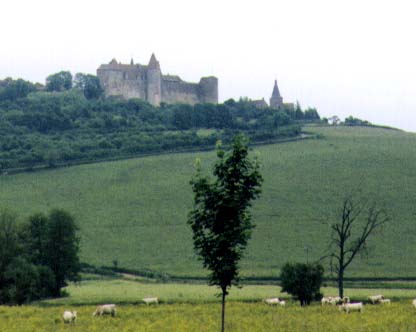
Châteauneuf-en-Auxois
The next morning we started to get into the daily schedule of the Lanikai. Breakfast was on the table at 8 a.m., with a plethora of choices including baguettes and other fresh pastries (that was bought every morning from a nearby village), fresh fruit, cereal, juices and coffee. After breakfast, a jaunt was usually made to a nearby point of interest. That first morning we were taken to the château on the top of the hill, Châteauneuf-en-Auxois. This château was originally built in the 13th century, and rebuilt and expanded in the 15th century. We wandered through the huge rooms and small staircases, explored the castle defenses and admired the expansive view of the surrounding countryside. To our surprise, the chapel contained a replica of a striking tomb sculpture, the original of which we had seen in the Louvre [link]. This was the tomb of Phillipe Pot, Grand Seneschal of Burgundy, who died in 1493. We also wandered through the surrounding village, admiring the medieval architecture.
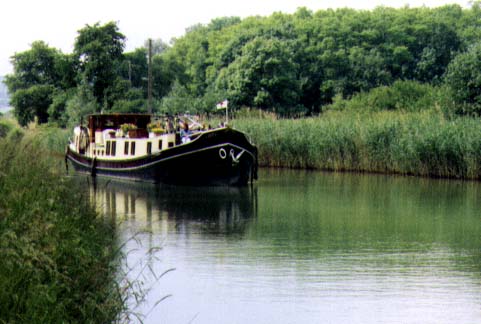
Cruising on the Burgundy canal
We then went back to the Lanikai, and got underway. When the weather was nice we sat out on deck chairs and watched the scenery go by at a leisurely barge pace. We watched the quiet countryside, farmers working in their fields and fishermen trying their luck in the canal, looked at wildflowers, cows, small villages and châteaux in the distance, and every once in a while, another barge. When it was drizzly, we would relax on the bench in the wheelhouse and watch Alan or Janette as they steered the barge, or curl up with a good book in the salon. The Lanikai travels at a fast walking pace, making it easy to get off and stretch a bit, or to take side trips on the mountain bikes.
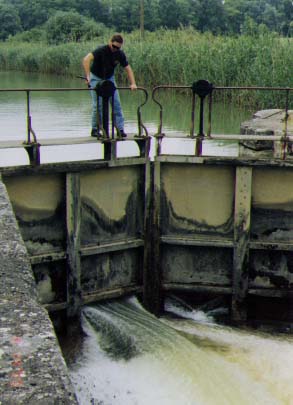
I worked off some of the good meals by helping operate the locks
There are tow paths on both sides of the canal, which were originally used by teams of horses to tow the barges along the canal. You can still see the grooves in the low stone bridges that were worn by the tow ropes. Every so often, depending on the grade of the surrounding land, the barge must go through a lock to adjust to the new elevation. The Burgundy canal was built in the mid-1800's by Napoleon III, and the locks are still original equipment. The locks are hand-operated and manned by lockkeepers, who live in houses built right by the locks. Originally, when the traffic was much heavier, there was a lockkeeper for each lock. Now a lockkeeper follows a barge for a long section of the canal, operating each lock as they go. Some of the lockhouses are still occupied, others have been converted into small shops and studios, and some are empty. Operating a lock is much more efficient with two people, and the lockkeepers welcome a hand at turning the cranks and opening the water doors.
Lunch was served aboard while underway. A gourmet cook, Jannette created culinary delights for the four-course meal. It started with a main course featuring a seasonal or local specialty such as pâté, artichokes, or quiche and was followed by a salad garnished with herbs and flowers from Janette's deck-top garden. In true French fashion, an assortment of three or four local cheeses was served, complemented with a red wine, often from a château in the area we had been passing through. By the end of the week we had tried the full spectrum of cheese varieties; for an American, who had not been exposed to many non-pasteurized cheeses, this was a rare and wonderful experience. The meal concluded with a delectable homemade dessert, such as torte, melon ice cream, or Janette's specialty, a Pavlova.
During the afternoon of our first day of cruising we passed though a two mile-long tunnel. This tunnel was at the highest elevation on the canal; we had been going up in the locks earlier, and for the rest of the trip, we were going down. This tunnel had been dug through a mountain by prisoners of war. It was only two feet wider than the barge, and the wheelhouse had to be dismantled to clear the low ceiling. There were vertical shafts admitting air and some light every few hundred feet. We brought the speakers up and played Enya's Watermark album as we floated through the darkness; surreal.
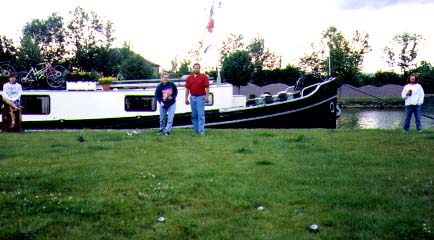
Playing lawn bowls
We docked for the night at 5 p.m., since the lockkeepers quit promptly at that time. Some evenings we went on an excursion to a nearby point of interest or took a walk through the local village; once we played the French game of lawn bowls; and other times we would just relax on deck with a beer and talk before going out for dinner to a nearby restaurant or château. By our own choice, our dining ran the gamut from 'auberge' to 'haute cuisine'. The countryside was peaceful and quiet in the evening, making for restful nights.
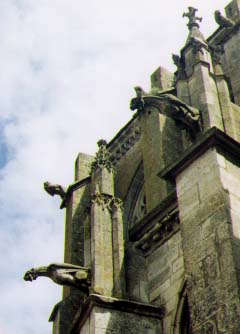
The chapel of a ruined medieval cathedral
On succeeding days, we took side trips to many different places. We visited a medieval walled city, Semur-en-Auxois, and wandered through its crooked streets. It had a very old church with flying buttresses and interesting animal gargoyles and carvings on the facade, although some had been defaced during the revolution. We took another side trip to a medieval cathedral; the main part had fallen down in the 15th century, but the chapel remained. There was the tomb of a crusader in the chapel, and beautiful stained glass windows. The front of the chapel was intricately carved, with several striking gargoyles.
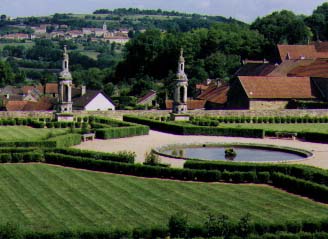
The gardens of the château of the Duke of Bussy
We went to the château of the Duke of Bussy, who was exiled from the court of Louis XIV for his satirical writings about the women and the excesses of the court. This expansive château was noteable in that the interior walls were completely painted with portraits. One room featured all of the French kings, another exalted beautiful women of the day, including his mistresses, and another was devoted to contemporary nobles. Many of the pictures were subtitled with descriptive phrases that had an insulting double meaning! There were extensive gardens, and a beautiful view across the valley.
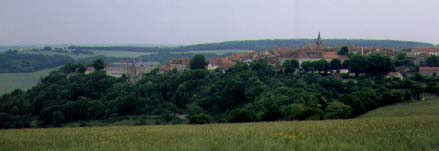
Flavigny, from a nearby hilltop
Another day, we went to Flavigny, site of a very old monastery famous for its pastilles (anise seed candy). The town was built on a steep hill, and we walked through the ancient catacombs that had been excavated. This was one of my favorite places, since I've loved Flavigny pastilles since I was a kid. We also went to Alésia, the site of the fall of Gaul to Julius Caesar, and saw the huge statue of Vercingétorix. We visited the excavation of the Roman ruins, and a museum that had many Roman artifacts and showed the research that went into determining the actual location of the battlefield of Alésia. This was one of Marie's favorite places, since she is a big fan of Asterix and Obelix.
All too soon our week of cruising came to an end, and we reluctantly left for Paris. We had a wonderful time aboard the Lanikai. The entire week was a relaxing and fun-filled vacation for us, and turned out to be the high point of our month in Europe; the lodgings were superb, our hosts were very friendly and accommodating, and the value was outstanding. We're already saving money and making plans for another trip on the Lanikai in the future!